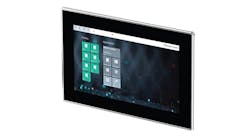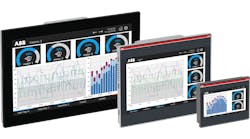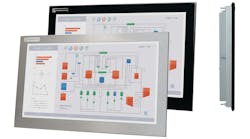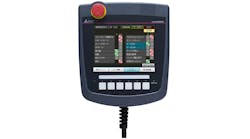Industrial computers are so fast, capable and flexible these days that they can run almost anywhere. However, some users have discovered that the best way to apply their data processing power is to send thin-client interfaces into the field, and do the number crunching back at the ranch.
Chris Alexander, P.E., process controls engineer at Givaudan Flavors Corp. in Cincinatti, Ohio, reported that his company's U.S. facilities have long used many different control systems and software, but it's acquired so many smaller plants in recent years that it now has an even bigger and more varied patchwork of human-machine interfaces (HMIs), process controls, automation systems and software packages. He presented "Flavor-maker boosts consistency with modern production systems, thin-client HMIs" this week at the Rockwell Automation's TechED 2017 conference in Orlando, Fla.
"At five of our flavor plants in North America, we had five different situations," said Alexander. "Givaudan had no global automation group, so each region had been left to its own devices." These five facilities included:
- Newest plant in Devon, Ky., was just 10 years old, but nothing had been updated since its initial commissioning;
- Oldest plant in Carthage, Ohio, was celebrating 100 years, but needed new HMIs because it was using retired computers with Microsoft XP;
- Largest plant in East Hanover, N.J., was an alphabet soup of control systems from Rockwell Automation, ABB, GE and Emerson;
- Smallest plant purchased just a few years ago in Itasca, Ill., had controls that were more than 20 years old; and,
- Small plant in Lakeland, Fla., with up-to-date DeltaV controls from Emerson.
Uphill HMI upgrade
Alexander reported that he and his colleagues at Givaudan began their HMI upgrade journey in the liquids department at the Carthage plant, but retiring its 13 computers running XP and upgrading their existing GE Cimplicity software to an operating system newer than XP was going to cost $80,000, plus another $80,000 for implementation and proprietary software.
[sidebar id =1]
"The IT department would maintain the computer in the HMI panel because they owned the material consumption and SAP software, but the HMIs were all hosted on the same machine," explained Alexander. "Operators complained that the HMI would take up to two days to get back up and running once IT received a ticket. IT would also provide a standard build, but then the local controls engineer had to go out to the floor, install the GE software and licensing, and fight network issues to get it to reconnect to the PLC.
"In addition, the Carthage plant was averaging about one failure per quarter, which translates to about a three-year lifespan for PCs and an average of 20-30 man-hours per year to replace them. Also, there would be software issues that would make the PC unavailable, and require IT to reboot or possibly troubleshoot application issues with new software revisions."
Even though the plant was spending more than $23,000 per year on labor, hardware and software to keep its existing HMIs running, Alexander added, the only cost initially considered was the $500 per PC for new PCs. "It's hard to put a price tag on operator frustration."
Getting thin
Consequently, Alexander added that he and personnel at the Carthage plant employed ThinManager's ROI calculator, and modified their upgrade plan to possibly use thin-client HMIs as a pilot project. Recently acquired by Rockwell Automation, ThinManager is defined as a "computer replacement and management tool" with ThinReady interfaces. At Givaudan, they run on Arista Microboxes in the field, which display but don't run software, and can be rebooted and reconnected in a couple of minutes. They can also share operating displays using a remote Shadow feature, which makes it far easier for engineers and managers to collaborate on troubleshooting tasks with their operators in different applications and facilities.
The Carthage plant replaced the 13 PCs in its liquids department with thin clients in 2013, while the East Hanover plant got thin clients as part of its DCS upgrade in 2013-14. Thin clients were implemented at the Devon facility as part of its blender upgrade, which also included industrial PCs from Rockwell Automation. Finally, the Itasca plant added thin clients in 2016 along with its PLC upgrade. Back at Carthage, the 13 HMIs running RSView 32 software were also replaced.
Alexander added that system integrator Interstates Control Systems Inc., Sioux Falls, S.D., has helped Givaudan with many of its thin-client projects.
Big access, flexibility, gains
Since it started upgrading to ThinManager, Alexander reported that Givaudan has been making gains on all operational fronts.
"We've increased uptime compared to our previous PCs. In fact, we've only had one failed thin client out of 80 operating over the past four years," said Alexander. "However, probably the biggest help has come from ThinManager's remote Shadow feature that lets us see displays from anywhere in the world. For example, when a spray dryer goes down at 2 a.m., its operators can show on-screen exactly what they're doing. This puts the engineers on the same page as the operators, lets the engineers remotely operate the HMI, and walk the operators through the solution. This makes many problems much easier to solve."
Other gains at Givaudan's facilities include:
- Built-in uptime and reboot reporting with ThinManager;
- Low power consumption of less than 40 watts per thin-client unit, compared to the 130 watts typically used by a PC. This results in savings of about 788 kilowatt hours annually, or about $100 per year per PC;
- Ability to view multiple HMIs, and then integrate CMS SAP software into one HMI station; and,
- Automatic reboot after any power failures or network losses.
"In addition, thin clients make it easier for us to add another HMI anywhere in the plant later, and see anything from a single point," said Alexander. "Our IT department also accepts this technology, and prefers to maintain a virtual machine (VM) rather than a PC on the production plant floor. When the Wannacry ransomware cyber attack showed up recently, we were able to use thin-client capability to remotely check all the screens at our plants to make sure they were unaffected."
Alexander added that Givaudan is already planning to host more than 30 thin clients in the second half of 2017 at one of its greenfield plants in India. “In 2018, we're going to implement thin clients in China, and in 2020, more thin clients will go in, including extending them to smart phones and other mobile devices."






